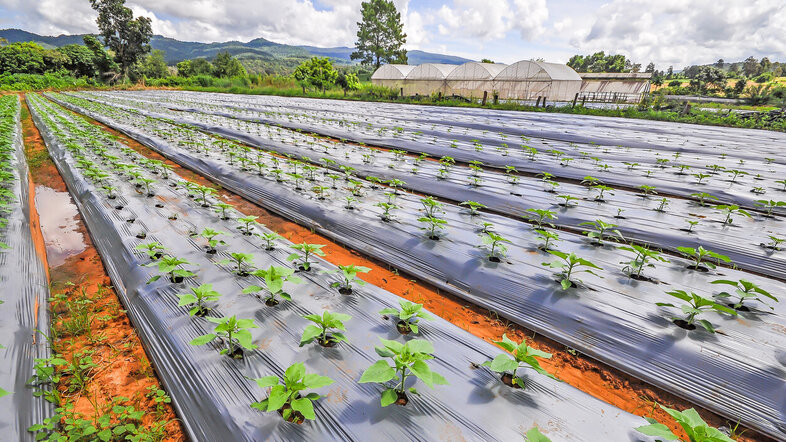Can we feed the world population of 2050 without plastic in agriculture?
Once celebrated as a symbol of modern innovation, plastic has become the boon and bane of our time. From ubiquitous packaging to the threads woven into the fabric of our clothes, plastic is everywhere. This is also true in the world of agriculture. Here, plastic plays a multifaceted role: From mulch films that protect crops to water-saving irrigation systems, plastic is deeply embedded in our food production.
But as we face the challenge of feeding a projected 10 billion mouths by 2050, the question arises: Can we, and more crucially, should we, continue to rely so heavily on plastic?
Plastic increases yields while reducing our ecological footprint
Modern agriculture, which is responsible for nearly a third of global greenhouse gas emissions and drawing heavily on our planet's resources, is inextricably intertwined with plastic. According to the UN Food and Agriculture Organisation (FAO), over 12 million tonnes of plastic are used in agriculture every year. From securing plants with fastening clips to protecting them with shelters and nets, plastic has found its way into every crevice of the farming ecosystem.
On the plus side, the use of plastic in agriculture undeniably conserves essential resources. Leading the charge is mulch film, accounting for around 50 % of all agricultural plastics. Mulch films not only control weeds and pests, but also preserve soil moisture, modulate temperatures, and enhance nutrient uptake. In this sense, plastic is the unassuming player in reducing the environmental footprint of agriculture: optimising water and nutrient use, limiting pesticide requirements, and increasing crop yields at the same time. In China, avoiding mulch film would necessitate an extra 3.9 million hectares of arable land to maintain current levels of food production.
Some small but powerful allies are completing the plastic arsenal: fastening clips, irrigation pipes, nets, shelters, silage covers, agrochemical vials, and more. Another powerful player is even more hidden and goes largely unheralded: water-soluble polymer coatings. Over the past few decades, they have emerged as saviours in controlling nutrient release in fertiliser formulations (see info box below). Between 1976 and 2018, Japan used approximately 2.3 million tons of polyurethane- and PE-coated fertilisers, significantly ameliorating nutrient efficiency and reducing nutrient wastage.
What are controlled-release fertilisers?
In response to growing concerns about nutrient use efficiency, many farmers have embraced controlled release fertilizers (CRFs). CRFs are granular fertilisers coated with a semipermeable membrane. As the granules take up moisture from the soil, they gradually release nutrients (nitrogen phosphorus, potassium, etc.) into the soil over a predetermined period, ensuring plants receive a steady supply. CRFs have gained popularity across agricultural production due to their benefits:
- Nutrient efficiency: CRFs minimise nutrient loss through leaching or runoff, promoting efficient nutrient uptake by plants.
- Environmental stewardship: Reduced nutrient runoff helps protect water bodies from pollution, benefiting ecosystems.
- Crop health: Controlled nutrient release supports consistent plant growth, resulting in healthier, more productive crops.
However, many formulations for CRFs contain polymers, such as polyolefin or polyvinylidene chloride which are released into the soil as CRF granules degrade. These polymers cannot easily degrade and can accumulate over time.
The dark side of plastic in our food systems
But there is a dark side to plastic, and it comes in different flavours: Tainted soil fertility and dwindling yields caused by accumulated micro- and nanoplastic, and the chilling prospect of toxic additives seeping into our food chain. Conventional plastics persist in the environment, with residues accumulating in our soils. In the long term, the leftovers from mulch films can reduce water penetration and retention, disrupt microbial habitats, and decrease soil fertility.
Furthermore, plastics are not passive inhabitants of our soils. Plants might take up tiny plastic particles. Although research on nanoplastic uptake is in its infancy, preliminary data cannot rule out that these plastics may enter our food chain. A clear understanding of these dynamics is imperative to ensure food safety. We now know that in the long term, the traces of plastic we leave behind in the agricultural process pose significant long-term environmental risks. This has yet to gain the attention of both policymakers and the public.
Should we try to loosen the grip of plastic on agriculture? It would be naive to dismiss the central role of plastic in agriculture. But uncritical reliance on it, without adequate recycling and sustainable practices, can be a significant environmental burden.
Our transition away from plastic should be slow and calculated
Our way forward lies in a well-orchestrated mix of sensible and sparing use of plastic and rigorous recycling and reuse. Efficient collection and reprocessing systems must be in place. This is necessary to move from disposable to reusable plastic, backed by legally binding quotas. And where plastics do remain on our fields, they should be fully biodegradable and free of harmful additives. This requires research and innovation.
While bio-based materials offer an enticing alternative, they’re not without their caveats. A rush to adopt such materials without adequate consideration of their life cycles could inadvertently wreak havoc on our ecosystems and food networks. The cautionary history of first-generation E10 fuels serves as a sobering reminder, where mandated use triggered competition for arable land and exacerbated pesticide runoff into groundwater. A more holistic approach—based on regional considerations rather than a one-size-fits-all strategy—is the need of the hour.
With these measures, aligned with global initiatives such as the UN Plastics Treaty, we can foster a more sustainable symbiosis between agriculture and plastic. While completely replacing plastic seems unfeasible, the reasonable use of alternatives with minimal ecological fallout seems a promising path. With vigilant monitoring, technical advancements, and community-driven education initiatives, we can indeed build a future where plastics are used more sustainably in agriculture, paving the way for a greener tomorrow.
Together with Sabine Pahl, he is heading the new Environment and Climate Research Hub.
- Plastics can be used more sustainably in agriculture - Current paper by Hofmann et al
- Centre for Microbiology and Environmental Systems Science (CMESS) at the University of Vienna
- Research group of Thilo Hofmann at the Division of Environmental Geosciences (EDGE)
- Research Platform PLENTY - Plastics in the Environment and Society
- FAO factsheet on plastic in agriculture
- What you need to know about the UN plastic pollution resolution

